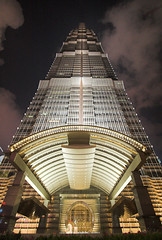The Jin Mao Tower (Chinese: 金茂大厦; pinyin: Jīn Mào Dàshà; literally "Golden Prosperity Building") is an 88-story landmark supertall skyscraper in the Lujiazui area of the Pudong district of Shanghai, People's Republic of China. It contains offices and the Shanghai Grand Hyatt hotel. Until 2007 it was the tallest building in the PRC, the fifth tallest in the world by roof height and the seventh tallest by pinnacle height. Along with the Oriental Pearl Tower, it is a centerpiece of the Pudong skyline. It was surpassed on September 14, 2007 by the Shanghai World Financial Center.
The building is located on a 24 000 m² plot of land near the Lujiazui metro station.
It was designed by the Chicago office of Skidmore, Owings & Merrill. Its postmodern form, whose complexity rises as it ascends, draws on traditional Chinese architecture such as the tiered pagoda, gently stepping back to create a rhythmic pattern as it rises. Like the Petronas Towers in Malaysia, the building's proportions revolve around the number 8, associated with prosperity in Chinese culture. The 88 floors (93 if the spire floors are counted) are divided into 16 segments, each of which is 1/8th shorter than the 16-story base. The tower is built around an octagon-shaped concrete shear wall core surrounded by 8 exterior composite supercolumns and 8 exterior steel columns. Three sets of 8 two-story high outrigger trusses connect the columns to the core at six of the floors to provide additional support.
The foundations rest on 1,062 high-capacity steel piles driven 83.5 m deep in the ground to compensate for poor upper-strata soil conditions. At the time those were the longest steel piles ever used in a land-based building. The piles are capped by a 4 m-thick concrete raft 19.6 m underground. The basement's surrounding slurry wall is 1 m thick, 36 m high and 568 m long, and composed of 20,500 m³ of reinforced concrete.
The building employs an advanced structural engineering system which fortifies it against typhoon winds of up to 200 km/h (with the top swaying by a maximum of 75 cm) and earthquakes of up to 7 on the Richter scale. The steel shafts have shear joints that act as shock absorbers to cushion the lateral forces imposed by winds and quakes, and the swimming pool on the 57th floor is said to act as a passive damper.
The exterior curtain wall is made of glass, stainless steel, aluminium, and granite, and is criss-crossed by complex latticework cladding made of aluminum alloy pipes.
Official dedication was August 28, 1998, a date also chosen with the number 8 in mind. The building was fully operational in 1999.
The Jin Mao Tower is owned by the China Jin Mao Group Co. Ltd (formerly China Shanghai Foreign Trade Centre Co. Ltd). It reportedly has a daily maintenance cost of 1 million RMB (US$121,000).
Source: wikipedia

No comments:
Post a Comment